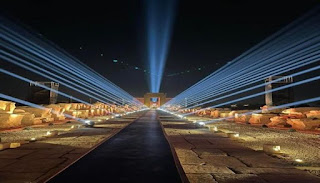A legendary ceremony and the opening of the Road of the Holy Rams in Luxor
For the first time in nearly 3,500 years, the Road of Rams reappeared on Thursday evening, as it includes more than a thousand statues in the form of a lion's body and a ram's head, and links between the Karnak Temple and Luxor Temple in southern Egypt.
During a solemn celebration in Luxor, Rams Road was reopened after its restoration, in the presence of Egyptian President Abdel Fattah El-Sisi.
At the beginning of the celebration, Minister of Tourism and Antiquities Khaled al-Anani said that the road "includes 1,057 statues."
………………………………………………………………
The length of the road of rams is 2.7 km, and it was built by King Nectanebo I, founder of the 30th Pharaonic dynasty (380-362 BC), in its final form, where he placed the sphinxes with rams’ heads with a memorial inscription, in which he says: “I created a beautiful road for Abu Amun Ra surrounded by walls and decorated with flowers. to sail it to Luxor Temple.
………………………………………………………………………
The complex of the Karnak and Luxor temples, as well as the pharaonic tombs in the Valley of the Kings and the Valley of the Queens, are all registered as a UNESCO World Heritage Site.
The pharaonic antiquities are one of Egypt's most important tourist wealth, and they are a source of national pride in a country that boasts a civilization that spans thousands of years.
...................................
Egypt succeeded in drawing the world's attention to it, with a "dazzling" ceremony to open the Rams Road in the southern city of Luxor, on Thursday, which won praises from several sides outside the country.
In a solemn festive atmosphere that mixed modern technological influences and the scent of ancient history, Egypt reopened the 3,400-year-old archaeological road, which witnessed major processions that crossed it and is guarded by more than a thousand statues on both sides.
The ceremony included an artistic show that simulated some aspects of the ancient Egyptians' celebration of the Opet Day, in which hundreds of Egyptian university students in pharaonic costumes participated, and President Abdel Fattah El-Sisi and a number of government members and foreign and Arab ambassadors attended.
...................
In April, the world's televisions broadcast a large celebration held on the occasion of the "mummy procession", during which the mummies of kings and queens from the Pharaonic era were transferred from the Egyptian Museum in Tahrir to the new Museum of Egyptian Civilization.
In the coming months, Egypt intends to open another new museum, the "Grand Egyptian Museum", which is being built at the foot of the pyramids and will be an alternative to the current Egyptian Museum in Tahrir Square, which no longer has the capacity to display hundreds of pieces in the stores of the Egyptian Ministry of Antiquities in Tahrir.






Comments
Post a Comment